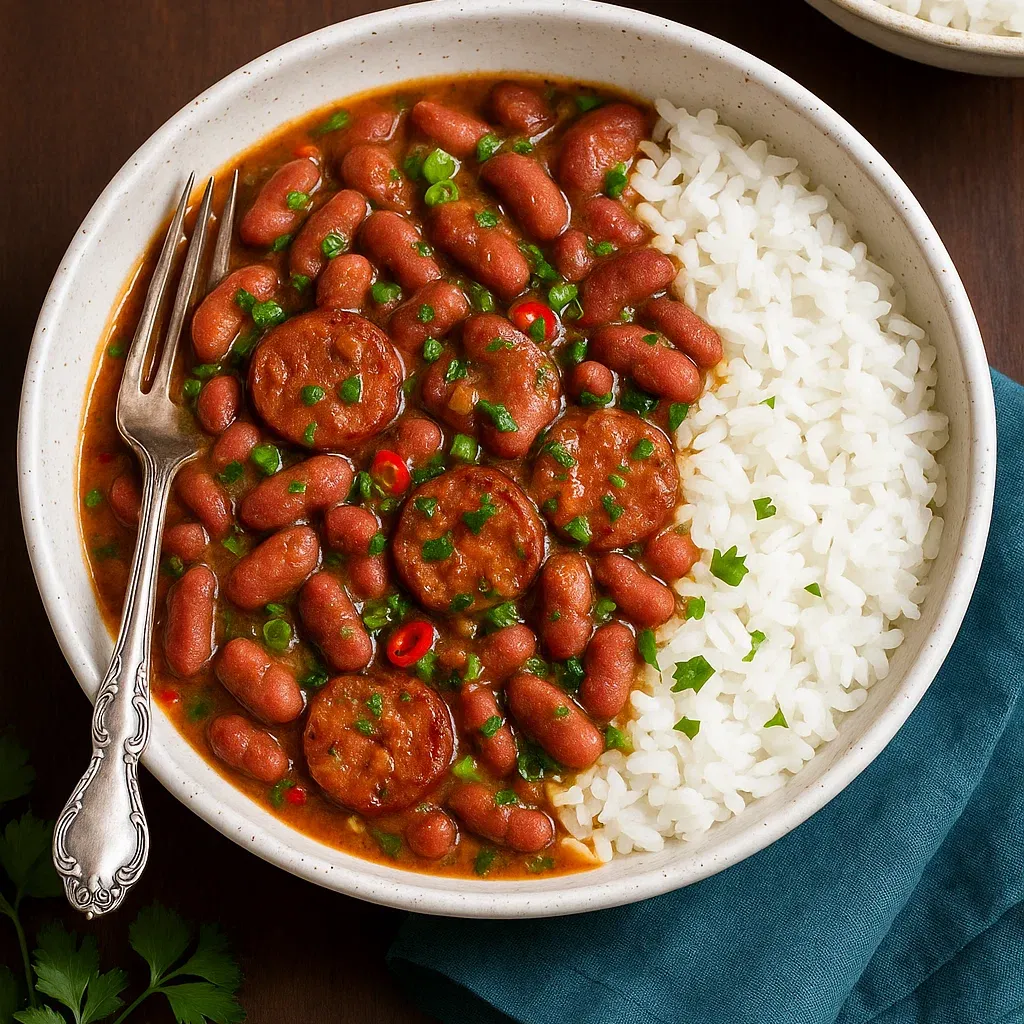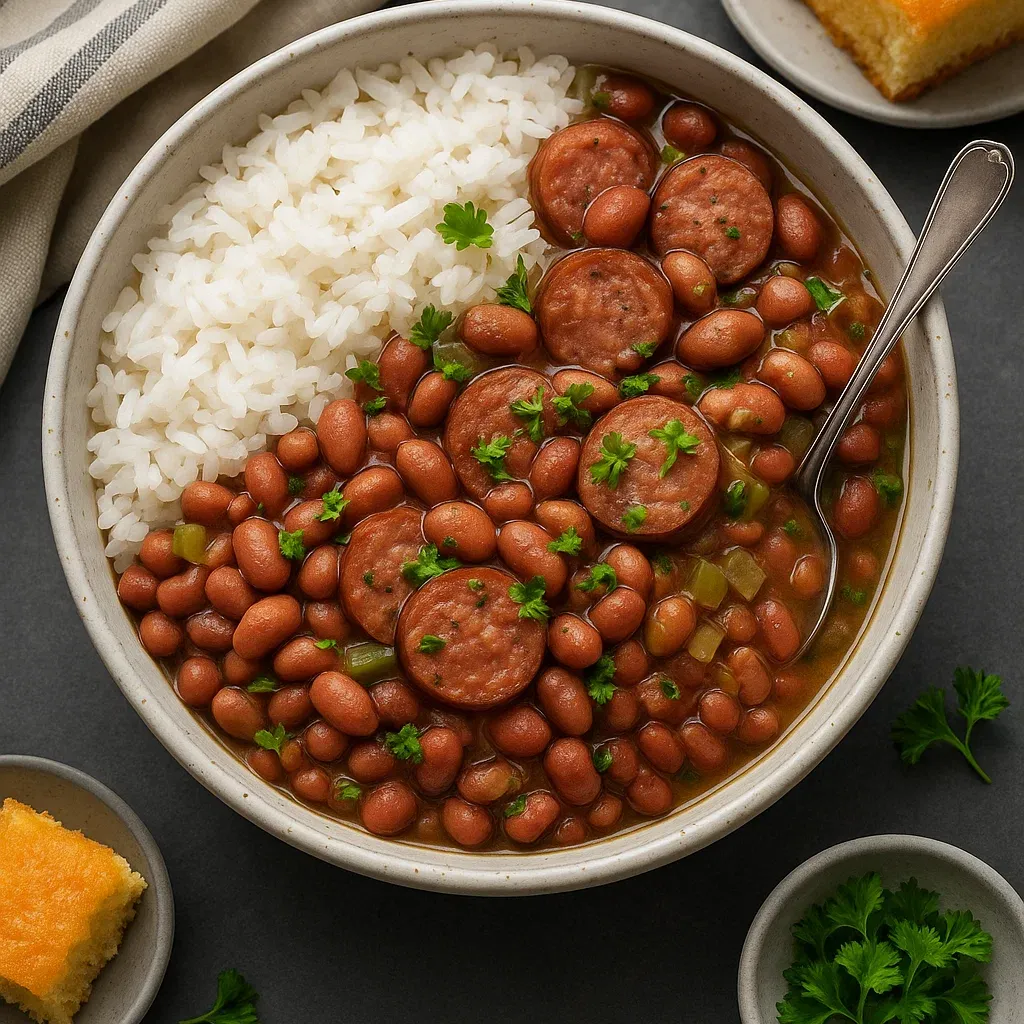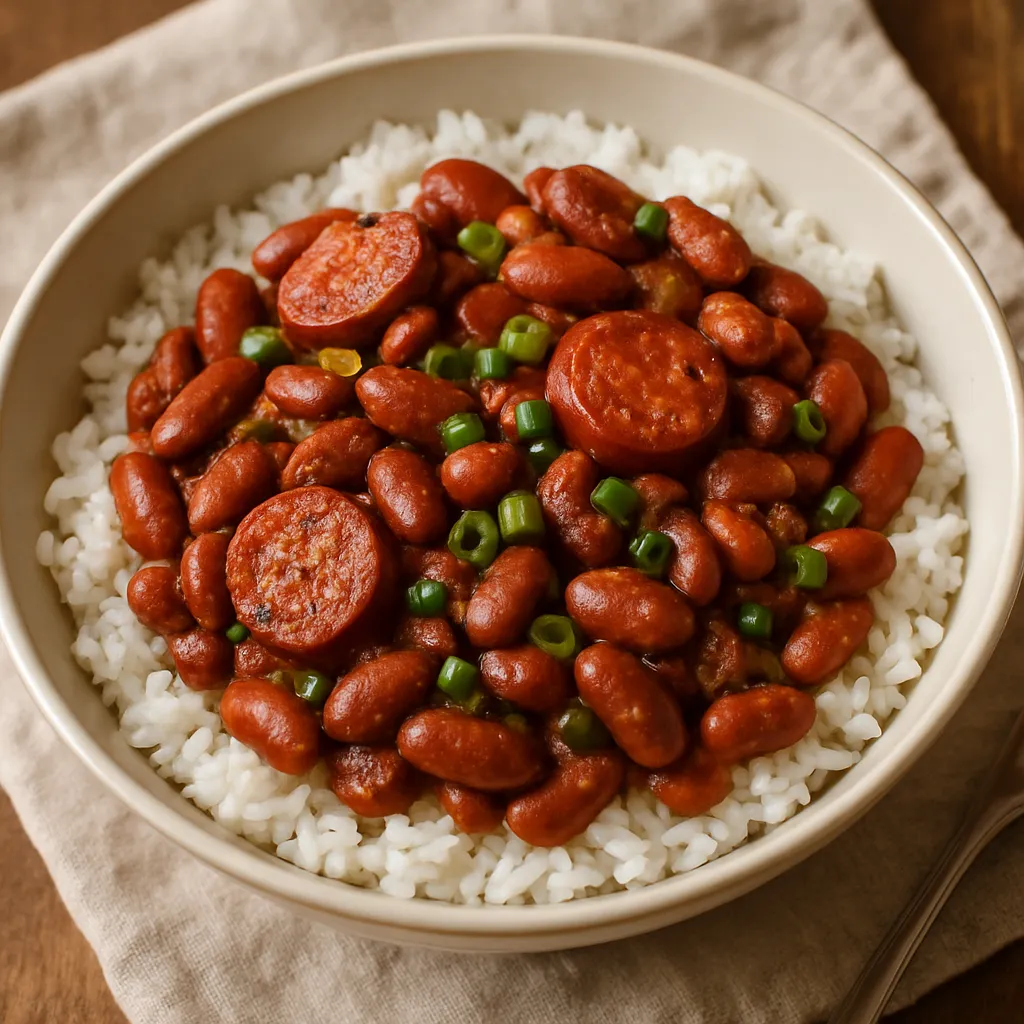Prep Time: 15 minutes (plus overnight soaking) | Cook Time: 2 hours 30 minutes | Total Time: 2 hours 45 minutes | Serves: 6-8
Why This Red Beans and Rice Recipe is Pure Louisiana Magic
There’s something deeply satisfying about a dish that fills your kitchen with the kind of aromas that make neighbors stop by “just to say hello.” This authentic red beans and rice recipe does exactly that – it transforms simple ingredients into a soul-warming masterpiece that’s been bringing families together around Louisiana dinner tables for generations.
What makes this recipe special isn’t just the incredible depth of flavor that develops over hours of slow simmering, though that’s certainly part of it. It’s the way each component works in perfect harmony – the smoky richness of authentic andouille sausage, the creamy texture of properly cooked red beans, and the aromatic foundation of the holy trinity vegetables that form the backbone of all great Cajun and Creole cooking.
I learned this recipe from my friend Marie, whose grandmother immigrated from Louisiana to share her family’s traditions. The first time I made it, I understood why Monday red beans and rice became such a cherished tradition in New Orleans households. It’s the kind of dish that requires patience but rewards you with flavors so complex and satisfying that you’ll find yourself making it again and again.
The secret to authentic red beans and rice lies in understanding that this isn’t just a recipe – it’s a technique, a tradition, and a testament to the power of simple ingredients transformed through time and care into something truly extraordinary.
Ingredients
For the Red Beans:
- 1 pound dry red kidney beans
- 1 pound andouille sausage, sliced into rounds
- 1 large yellow onion, diced
- 3 celery stalks, diced
- 1 large bell pepper, diced (preferably green)
- 4 cloves fresh garlic, minced
- 3 bay leaves
- 2 tablespoons olive oil
- 2 tablespoons butter
For the Seasoning Blend:
- 1 teaspoon salt (or to taste)
- 1/2 teaspoon black pepper
- 1/2 teaspoon cayenne pepper
- 1/2 teaspoon paprika
- 1/4 teaspoon dried thyme
- 1/4 teaspoon dried oregano
For Cooking and Finishing:
- 6-8 cups chicken broth (or vegetable broth)
- 1/4 cup fresh parsley, chopped
- 4 green onions, sliced
- 2 cups long-grain white rice
- Hot sauce for serving
The Foundation of Authentic Louisiana Flavor
Dry Red Kidney Beans: The Heart of the Dish
Using dry beans instead of canned makes all the difference in achieving that signature creamy texture that defines authentic red beans and rice. Dry beans absorb all the flavors during the long cooking process while maintaining their shape and developing that perfect tender-but-not-mushy consistency. Look for beans that are uniform in size and free from cracks or wrinkles.
Andouille Sausage: The Smoky Soul
This isn’t just any sausage – andouille is the cornerstone that gives red beans and rice its distinctive character. Authentic andouille is heavily smoked and seasoned with garlic, giving it a complex flavor that infuses the entire dish. If you can find it, seek out andouille from a Louisiana producer or specialty butcher. The difference in quality will be immediately apparent in every bite.
The Holy Trinity: Louisiana’s Flavor Foundation
Onions, celery, and bell peppers form what Louisianans call the “holy trinity” – the aromatic base that appears in countless Creole and Cajun dishes. This combination provides layers of flavor that build throughout the cooking process. The key is cutting them uniformly so they cook evenly and don’t overpower each other.
Fresh Herbs: The Bright Finish
While dried herbs season the beans during cooking, fresh parsley and green onions added at the end provide a burst of color and brightness that balances all those rich, deep flavors. Never skip this step – it’s what elevates the dish from good to extraordinary.
Step-by-Step Instructions for Red Beans and Rice Perfection
Step 1: Prepare Your Beans Like a Pro (The Night Before)
Place your dry red kidney beans in a large bowl and cover them with cool water, ensuring the water level is at least 2 inches above the beans. Add a pinch of salt to the soaking water – this helps soften the bean skins and ensures even cooking.
Let the beans soak overnight, or for at least 8 hours. This crucial step isn’t just about reducing cooking time; it’s about achieving that perfect tender texture that allows the beans to absorb all the wonderful flavors while maintaining their shape. Properly soaked beans cook more evenly and are easier to digest.
Before cooking, drain and rinse the soaked beans, discarding any that float or look damaged.
Step 2: Build the Flavor Foundation with Perfect Sausage
Heat olive oil in a heavy-bottomed Dutch oven over medium heat. Add the sliced andouille sausage in a single layer, making sure not to overcrowd the pan. This is where patience pays off – let each piece develop a beautiful golden-brown crust before turning.
The browning process is crucial because it creates fond (those delicious browned bits) on the bottom of the pot, which will add incredible depth to your final dish. Cook the sausage for about 6-8 minutes total, turning once, until both sides are nicely caramelized.
Remove the sausage to a plate, but leave all those flavorful drippings in the pot – they’re liquid gold for the next step.
Step 3: Create the Aromatic Holy Trinity Base
Add butter to the same pot with the sausage drippings and let it melt completely. The combination of sausage fat and butter creates an incredibly rich base for your vegetables.
Add the diced onions first and cook for about 3-4 minutes until they start to soften and become translucent. The onions should sizzle gently – if they’re browning too quickly, reduce the heat slightly.
Next, add the celery and bell peppers, stirring to combine. Cook this trinity for another 5-6 minutes, stirring occasionally, until all the vegetables are softened but not mushy. You want them to retain some texture to add interest to the final dish.
Step 4: Awaken the Spices and Garlic
Add the minced garlic to the vegetables and cook for just 30 seconds until fragrant. Be careful not to let it brown, as burnt garlic will add unwanted bitterness to your dish.
Now add all your dried seasonings – salt, black pepper, cayenne, paprika, thyme, and oregano. Stir constantly for about 30 seconds to toast the spices. This brief toasting releases their essential oils and intensifies their flavors dramatically.
Step 5: Build the Perfect Cooking Liquid
Pour in 6 cups of chicken broth, scraping up all those beautiful browned bits from the bottom of the pot with a wooden spoon. These caramelized pieces are packed with flavor and will dissolve into the cooking liquid.
Add the drained beans, browned sausage, and bay leaves to the pot. Bring the mixture to a rolling boil, then immediately reduce the heat to maintain a gentle simmer. You want just enough bubbling to keep things moving without being so vigorous that it breaks up the beans.
Step 6: Master the Long, Slow Simmer
Cover the pot partially (leaving it slightly ajar to allow for evaporation) and let everything simmer gently for 1.5 to 2 hours. During this time, stir occasionally and add more broth if needed to keep the beans covered.
The beans are done when they’re tender enough to mash easily between your fingers but still hold their shape. This is the sweet spot where they’ve absorbed maximum flavor without becoming mushy.
Step 7: Create That Signature Creamy Texture
Here’s the technique that separates authentic red beans and rice from ordinary bean dishes: remove about 1 cup of the cooked beans and mash them completely with a fork or potato masher. Return this bean puree to the pot and stir it in.
This creates the signature creamy, slightly thick consistency that makes red beans and rice so satisfying. The mashed beans act as a natural thickener while leaving plenty of whole beans for texture contrast.
Step 8: Perfect the Final Seasoning
Taste your beans and adjust the seasoning as needed. You might need more salt, a touch more cayenne for heat, or even a splash of vinegar to brighten the flavors. This is where your personal taste comes into play.
Remove the bay leaves and stir in the fresh chopped parsley and most of the sliced green onions, saving some for garnish. Let them cook for just 2-3 minutes to wilt slightly while maintaining their fresh, bright flavor.
Step 9: Prepare the Perfect Rice
While your beans are finishing, cook your rice separately using your preferred method. Long-grain white rice works best because it doesn’t get sticky and provides the perfect neutral base for the flavorful beans.
I prefer the absorption method: combine 2 cups rice with 3 cups water and a pinch of salt in a heavy-bottomed saucepan. Bring to a boil, reduce heat to low, cover, and cook for 18 minutes without lifting the lid. Let it rest for 5 minutes before fluffing with a fork.
Pro Tips for Red Beans and Rice Mastery
The Overnight Improvement: Red beans and rice actually tastes better the next day as all the flavors have time to meld together. Make it a day ahead for company and gently reheat, adding a splash of broth if needed.
Consistency Control: If your beans are too thin, simmer uncovered for the last 30 minutes. If they’re too thick, add warm broth gradually until you reach the perfect consistency.
Sausage Quality Matters: Invest in high-quality andouille from a specialty butcher or Louisiana producer. The difference in flavor is remarkable and worth the extra cost.
Freezer-Friendly: The bean mixture freezes beautifully for up to 3 months. Always cook rice fresh when you’re ready to serve.
Traditional Serving and Presentation
Serve the red beans over fluffy white rice in shallow bowls, allowing each person to mix the beans and rice to their preference. Garnish with the remaining sliced green onions and provide hot sauce on the side – Louisiana crystal hot sauce is traditional, but any vinegar-based hot sauce works well.
The beauty of this dish lies in its simplicity and the way each component maintains its identity while contributing to the whole. The rice provides a neutral canvas, the beans offer rich, complex flavors, and the fresh herbs add brightness and color.
Variations and Dietary Adaptations
Vegetarian Version: Omit the sausage and use vegetable broth instead of chicken broth. Add 1 tablespoon of smoked paprika and a few drops of liquid smoke to recreate that signature smoky flavor. Consider adding sautéed mushrooms for extra umami depth.
Ham Hock Traditional: For an even more traditional approach, use a smoked ham hock instead of sausage. Add it during the simmering stage and remove the meat when tender, shredding it back into the beans.
Spice Level Adjustments: Adjust the cayenne pepper to your heat preference, or add fresh jalapeños with the holy trinity vegetables for a different type of heat.
The Cultural Heritage of Monday Red Beans
This dish holds a special place in New Orleans culture, traditionally prepared on Mondays using the leftover ham bone from Sunday dinner. While families did laundry – a Monday tradition – the beans would simmer away, filling the house with incredible aromas and requiring minimal attention.
This practical approach to meal planning allowed busy homemakers to provide a nutritious, satisfying meal while tending to household chores. The tradition crossed all social and economic boundaries, making red beans and rice a true unifying dish in Louisiana culture.
Storage and Reheating for Best Results
Store the beans and rice separately in airtight containers in the refrigerator for up to one week. The beans actually improve in flavor over time as the seasonings continue to develop.
When reheating, add a splash of broth to the beans as they will thicken considerably when cold. Reheat gently on the stovetop rather than in the microwave to maintain the proper texture and prevent the beans from breaking down.
Why This Recipe Creates Food Memories
There’s something magical about a recipe that connects you to generations of home cooks who understood that the best meals aren’t rushed. This red beans and rice recipe teaches patience, rewards attention to detail, and creates the kind of soul-satisfying comfort food that brings people together around the dinner table.
Every time I make this dish, I’m reminded that some of the world’s greatest cuisines were born from humble ingredients transformed through technique, tradition, and love. This authentic red beans and rice embodies all three, creating a meal that’s both deeply satisfying and culturally significant.
Ready to master this Louisiana classic? Your kitchen is about to smell like pure comfort food heaven.











